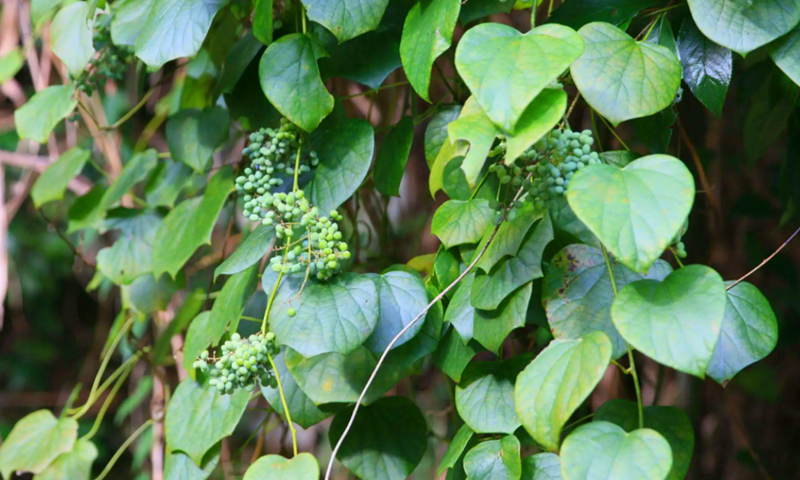Stephania(Han Fangji) is an herbaceous perennial vine native to Taiwan and China and belongs to the family Menispermaceae. It grows up to three meters tall, with a woody caudex. The leaves are spirally arranged along the stem, and are peltate, with the leaf petiole attached near the center. The plant produces a small, white blossom in the spring. It can be invasive and can damage a trellis or other structure. The vine has a short woody caudex and grows up to three meters and the leaves of the vine are arranged spirally on the stem and are peltate. The leaves are divided into cymes.
Generally, stephania comprises 60 species in the world and China has 37 species. Traditional Chinese medicine(MCT) has long used Stephania as a natural remedy for several ailments. Stephania root contains rich of isoquinoline alkaloids compounds: tetrandrine(12 to 23 grams/kg), fangchinoline(0.3–3 mg/kg), Cyclanoline, and dimethyltetrandrine iodide, also present are Cepharanthine, menisine, menisidine, oxofangchirine, stephenanthrine, stepholidine. The root also contains flavonoids. These compound offer good antibacterial and antiviral properties that inhibit inflammation for a wide range of ailments, including edema, arthralgia, boils, and eczema.
There has been widespread suspicion regarding this Chinese herb. Despite studies showing that it is harmless, the herb may be harmful to your health. It is important to read up on the side effects of Stephania extract before taking it. Before eating it, you should know this herbal supplement is not approved by the Food and Drug Administration.
In TCM, stephania root is used to fight edema and is classified as an herb that drains dampness. It has bitter, cold, and pungent qualities and affects the Spleen, Bladder, and Kidney. But it is important to note that it is different from Aristolochia fang chi, another medicinal plant with similar effects. This plant has been linked to cancer and can even cause kidney failure. It is available in powder form, but some specialty stores carry whole, dried peeled roots for a hot water decoction.
A potent extract of this herb is produced using patented cold-processing and hyper-raw-extraction technologies. Its recommended daily dosage is 30-50 drops in water or your favorite juice. While it is generally safe to use, it should not be used by pregnant or lactating women. Consult with your doctor before using this supplement. Always follow the instructions on the label. Stephania root is an excellent herbal remedy for Lyme disease.
Stephania has strong antioxidant activity. They inhibit lipid peroxidation in the linoleic acid system. They also scavenge DPPH radicals. Compared to BHA and trolox, they have higher DMPD*+ scavenging capacity than their respective antioxidants. However, the DMPD*+ concentrations in humans were not significantly affected by the two plant extracts. These compounds can be used to preserve the nutritional value and prolong the shelf life of pharmaceuticals. Further research is needed to identify which plant extracts have the most potential for these uses.
The Chinese consider stephania root an herb with antibacterial and antiviral properties. It can also be used to treat abdominal distension. Genetic studies of Stephania have also revealed that a new gene, called St6OMT2, is responsible for the biosynthesis of BIAs. BIAs was detected as part of a PCA analysis. Tetrandrine is an important BIA Q-marker. Its presence in a steroid hormone may also indicate a role in the production of fibroblasts in the lung. This gene has the ability to catalyze the methylation of (S)-norcoclaurine. Furthermore, its expression pattern resembles that of St6OMT1, and its catalytic activity matches that of St6OMT1. As a result, it may play a similar role in S. tetrandra’s BIA biosynthesis.
Cepharanthine is a natural product found in Stephania tetrandra, Stephania sinica, Stephania cephalantha, and other varieties. Since the breakout of the covid-19, research on this has continued, and it has been found that it can inhibit novel Coronavirus replication in vitro. The alkaloids cepharanthine are members of the family of bisbenzylisoquinoline alkaloids from toots of Stephania. It is ether-soluble and optically active. It is non-phenolic and aqueous solution crystallizes only from benzene. The chemical structure consists of two methoxy groups and one methylenedioxy group. Cepharanthine promotes the proliferation of bone marrow tissue, thereby increasing leukocytes in the peripheral blood and promoting recovery of immunologic function in lymphatic system after administration of antineoplastic agents or x-irradiation. Some China factories can produce USP/EP 99% grade cepharanthine. Its top-quality powder is highly recommended for human nutritional products, cosmetics, and health care.
A review of recent studies on cepharanthine and HIV infection has shown that it inhibits HIV-1 in a unique way. This Stephania extract inhibits the expression of HIV-1 long terminal repeat genes. The compound also inhibits NF-kappaB activation, inhibiting HIV-1 replication in TNF-alpha-stimulated U1 cells. In addition, it suppresses HIV-1 LTR-driven gene expression in a monocytic cell line, which demonstrates its anti-viral activity. Stephania inhibits the entry of HIV-1 into human cells by stabilizing the fluidity of the plasma membrane. Inhibition of HIV-1 replication in human lymphocytes was found to be 50% more potent at a concentration of 2.2 ug/ml compared to a control group. The anti-HIV properties of Stephania provide a rationale for further investigation. It has also been used for a wide range of medical conditions, from radiation-induced leukopenia to xerostomia.
- Dandelion Extract: What It Is, Benefits, Uses and Side Effect - April 23, 2024
- Is Berberine Extract Help For Weight Loss? - April 11, 2024
- Why Is Pysllium Husk Powder A Popular Meal Replacement Ingredient? - April 3, 2024



